Gebrüder Dassler Schuhfabrik ' is how the history of Adidas and Puma, now two commercial giants in the world of sports, began, but whose birth took place in the heart of athletics.
In the early 1920s, the brothers Adolf and Rudolf Dassler designed shoes and spiked shoes for those daring men who enjoyed running libre in Herzogenaurach, a quiet, small Bavarian village. The excellent quality of the materials used in their manufacture, together with their great resistance, led Josef Waitzer, the coach of the German athletics team, to take an interest in the Dassler brothers' product with a view to the Olympic Games in Berlin in 1936.
However, the German athletes were not the only ones who wore the Dassler brothers' superb shoes at those Olympics. To Hitler's disgrace (those were his games), a black boy from Alabama named Jesse Owens won the gold medal four times wearing spikes designed by Adolf Dassler.
Then came World War II and the transformation of the shoe factory into a workshop for tanks and weapons parts, by order of Hitler. This historic event aggravated the disagreements between the two brothers, as a result of their opposing points of view when it came to living life and running a company. From then on, each decided to go his own way. Adolf took over the original company. Rudolf, on the other hand, set up another factory from scratch on the other side of the Aurach River, taking half of the employees, almost all of them from the sales department, with him.
Thus, Rudolf Dassler created the RUDA sports footwear company in 1948, which would later be renamed PUMA. A year later, Adolf decided to compete with his brother and registered a new company under the name Adidas, the result of the combination of his name in diminutive form (Adi) and the first syllable of his surname (-Das), adopting a similar approach to his brother's commercial name.
Adidas logo
Adidas implements the tulip logo for all its products, until 1996, when the German company launches a new three-stripes design, where both logos coexist until today. Since the appearance of the second design, the original logo is only silkscreened on the brand's classic products to commemorate the history of Adidas, although other versions point to the metaphorical representation of three laurel leaves or a torch, as a symbol of the Olympics.

From 1996 onwards, the three stripes of the modern logo began to be the living image of Adidas, as a representation of the future and the future of the German company. However, other theories point out that this trio represents the three product segments of the brand: Adidas Originals, Adidas Sport Performance and Adidas Style.
PUMA logo
Although the current logo of this German firm is inspired by a stylized puma in attack position and jumping upwards representing speed, strength and agility, it is far from the original design dating back to 1968, in which the wild feline with eyes, mouth and nose, jumped in the middle of the letter "D" of the surname of its founder Rudolf.

The German company used the meaning of the word puma in Spanish to include a figurative image in its logo, which was modified in 1979. The puma depicted faithfully conveys the company's four pillars: passion, honesty, self-confidence and entrepreneurial spirit. PUMA is currently the sponsor and the brand responsible for equipping the greatest sprinter of all time: Usaint Bolt.
Logos: Adidas and PUMA (registered trademarks)
Read more news about: Running News

























